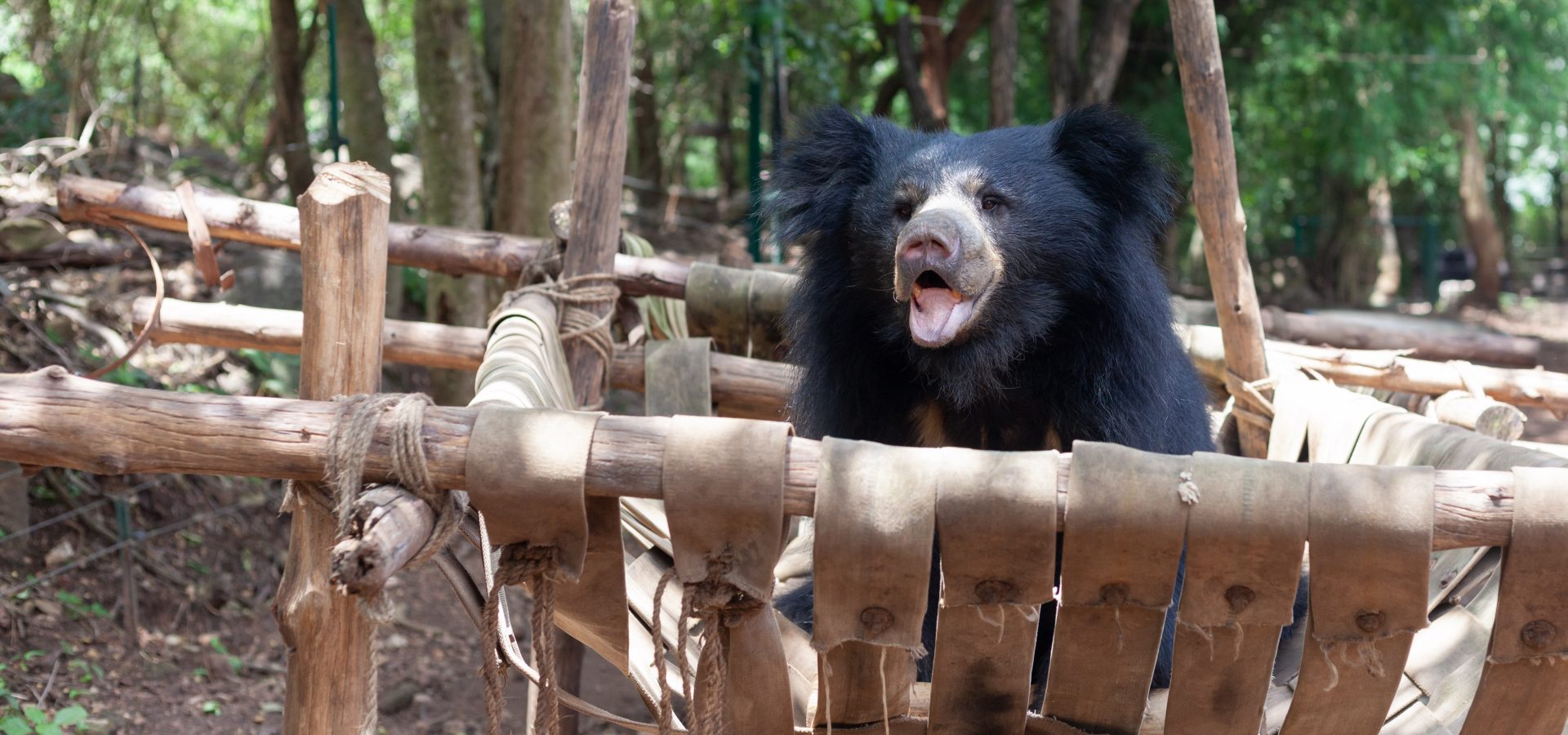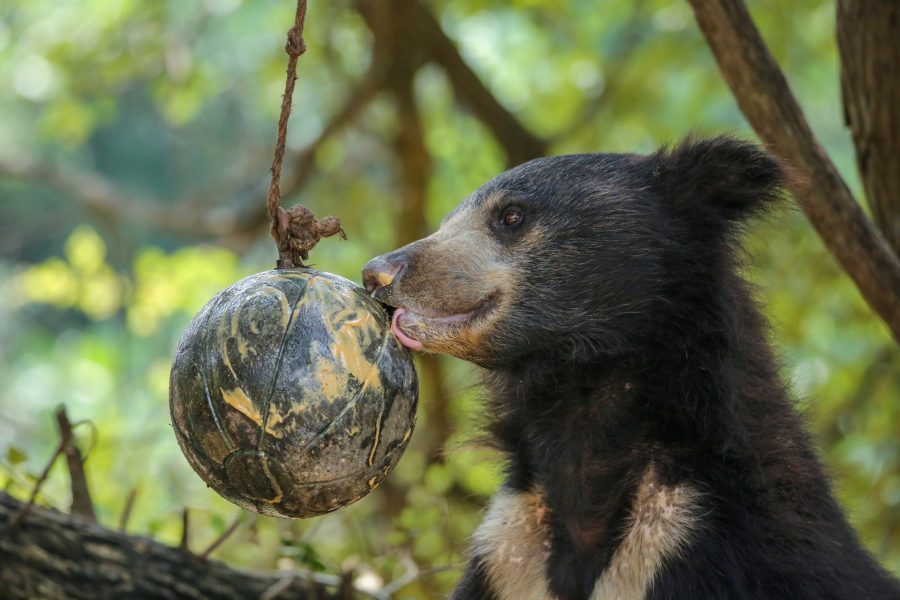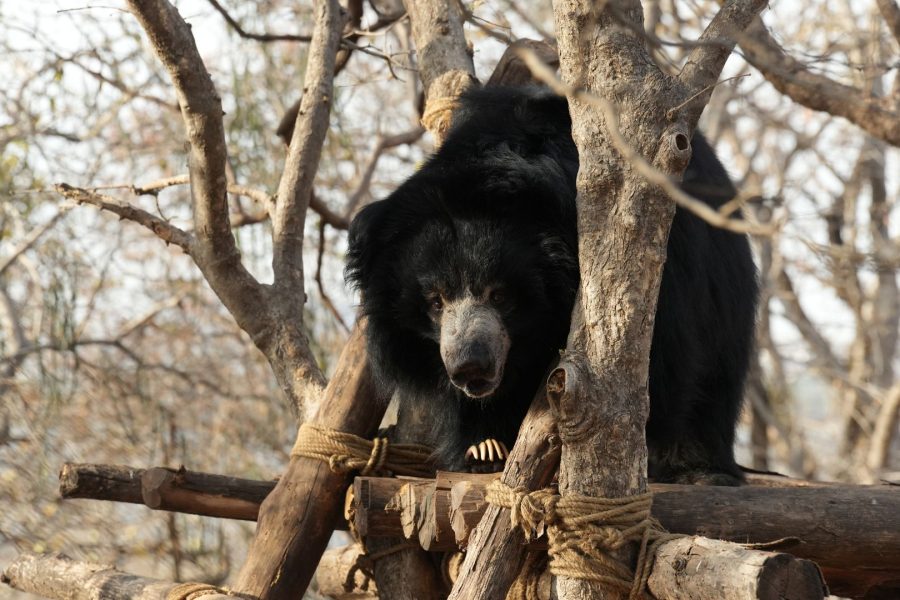Wildlife SOS embarked upon an iconic journey to resolve the ‘dancing’ bear practice in India. During this project, it was observed that the rehabilitated Sloth bears exhibited certain unique behaviours. The bears had faced immense trauma as a consequence of lack of resources and physical torture. These experiences manifest into stereotypic behaviour, wherein unintentional, repeated patterns of movement substitute the bears’ natural behaviour. These behaviours include excessive tongue flicking, pacing, grooming, head tossing, and swaying.
In order to reduce stereotypy and enhance the care for our rescued bears, Wildlife SOS has provided numerous enrichments for them. Enrichments are enhancements that encourage bears to portray species-specific behaviour. Digging pits, scouting for ants and termites, slurping sweet treats, climbing trees, finding a suitable spot to sleep, and even wrestling with others for fun are all behaviours that are natural to bears. Enrichments enable these activities to keep the bears physically and mentally active. The bears are motivated to use their senses and hone their behavioural, physical, social, and cognitive skills.
Enrichments by Wildlife SOS
All enrichments are directed at strengthening the skills of animals, and each activates certain specific behaviours of the animal. Enrichments can be classified as structural, social, cognitive, auditory, food-based, and olfactory. For Sloth bears at Wildlife SOS, environmental, olfactory and food-based enrichments have provided incredibly positive results.
- Environmental (or structural) enrichments: These include platforms, hammocks, soft mud, swings, pools and strategically planted trees. Each of these enables the bears to exercise their climbing skills and build strength. Environmental enrichments also encourage the bears to use their long, inwardly curved claws to dig. Pools of water in their fields also allow them to splash around during hot summer months.
- Olfactory (or food-based) enrichments: These consist of structural enrichments that are smeared with a generous quantity of honey and peanut butter. Sloth bears are encouraged to use their acute sense of smell to trace them. Alongside, chopped fruits and treats like coconuts and dates are also provided to the bears.
- Customised enrichments: Items such as balls, pipe feeders, rolling barrel feeders, tyre feeders, and braid feeders comprise these enrichments. They are often filled with fruits or treats and strategically placed around the fields by our caregivers. Enrichments are customised for animals with special needs: geriatric, blind, injured, or disabled animals. For instance, bells are fastened to the hanging enrichments for blind animals so that the auditory cue makes it easier for them to locate it.
Enrichments Encourage Natural Behaviour
Although setting up such enrichment items takes a great amount of time and resources, it has been an effective way to keep our rehabilitated Sloth bears engaged.
Since these bears, as opposed to their counterparts in the wild, do not traverse long distances to forage or seek shelter, our team sets up sophisticated, state-of-the-art facilities for them. Enrichment items ensure the animals receive the best possible care. As our Sloth bears invest large amounts of time with the enrichments, they are mental and physical capacities are stimulated. The concurrent activities to each enrichment also become opportunities for the bears to interact with one another and keep up their social skills.
Research, Training, and Awareness
In the past few years, there has been tremendous improvement in the care of animals at our rehabilitation centres due to research conducted by dedicated scientists and veterinary officers. Specialised training to caregivers and increased awareness of both physical and psychological needs of animals have been helpful to retain the pace of progress.
In 2010, a study was conducted by researchers from Linkoping University, Sweden in collaboration with Wildlife SOS to understand the efficiency of environmental enrichment (EE) in managing stereotypic behaviours of Sloth bears. Implementation of these enrichment items helps in reducing aggressive and stereotypic behaviour amongst bears. It also enhances the behaviour repertoire that animals are known to showcase in the wild.
The research involved observing 14 Sloth bears residing at the Bannerghatta Bear Rescue Centre (BBRC). Bears were provided with honey-laden logs, which were novel to them. Throughout the study, it was noted that the logs led to an increase in exploratory behaviours and reduction in stereotypy. Reduced stereotypic behaviours and enhanced active behaviours such as foraging, digging, walking, and socialising, indicates improved well-being.
Presenting honey-laden logs to bears was divided into two different ways: one way was to provide them with logs on consecutive days, and the other way was when logs were given after regular intervals. With this, researchers aimed to understand if the bears get habituated to this enrichment and, of the two methods, which was more effective in enhancing their welfare. While both treatments significantly reduced stereotypic behaviours, it was observed that providing the logs on each day had a longer lasting impact.
For animals in the wild, no two days are the same. To simulate this in the lives of rehabilitated animals, enrichment items are used. By providing specialised changes, they ensure the holistic well–being of our Sloth bears. To support the work that our team does for bear research and conservation, consider becoming a monthly donor.
For five fascinating facts on Sloth bears, click here!





